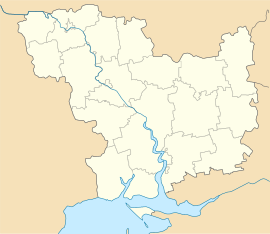Pontic Olbia
| Ὀλβία Ποντική (Ancient Greek) Ольвія (Ukrainian) |
|

The ruins of Olbia
|
|
| Alternate name | Olbia |
|---|---|
| Location | Parutino, Mykolaiv Oblast, Ukraine |
| Coordinates | 46°41′33″N 31°54′13″E / 46.69250°N 31.90361°ECoordinates: 46°41′33″N 31°54′13″E / 46.69250°N 31.90361°E |
| Type | Settlement |
| Length | 1 mi (1.6 km) |
| Width | 0.5 mi (0.80 km) |
| Area | 50 ha (120 acres) |
| History | |
| Builder | Settlers from Miletus |
| Founded | 7th century BC |
| Abandoned | 4th century AD |
| Periods | Archaic Greek to Roman Imperial |
| Cultures | Greek, Roman |
| Site notes | |
| Excavation dates | 1901–1915, 1924–1926 |
| Archaeologists | Boris Farmakovsky |
| Condition | Ruined |
Pontic Olbia (Ancient Greek: Ὀλβία Ποντική, Ukrainian: Ольвія) or simply Olbia is an archaeological site of an ancient Greek city on the shore of the Southern Bug estuary (Hypanis or Ὕπανις,) in Ukraine, near village of Parutyne. The archaeological site is protected as the National Historic and Archaeological Preserve. The preserve is a research and science institute of the National Academy of Sciences of Ukraine.
The Hellenic city was founded in the 7th century BC by colonists from Miletus. Its harbour was one of the main emporia on the Black Sea for the export of cereals, fish, and slaves to Greece, and for the import of Attic goods to Scythia.
The site of the Greek colony covers the area of fifty hectares and its fortifications form an isosceles triangle about a mile long and half a mile wide. The region was also the site of several villages (modern Victorovka and Dneprovskoe) which may have been settled by Greeks.
As for the town itself, the lower town (now largerly submerged by the Bug river) was occupied chiefly by the dockyards and the houses of artisans. The upper town was a main residential quarter, composed of square blocks and centered on the agora. The town was ringed by a defensive stone wall with towers. The upper town was also the site of the first settlement on the site in the archaic period. There is evidence that the town itself was laid out over a grid plan from the 6th century - one of the first after the town of Smyrna.
By the later period of settlement, the city also included an acropolis and, from the 6th century BCE, a religious sanctuary. In the early 5th century, a temple to Apollo Delphinios was also built on the site.
...
Wikipedia

